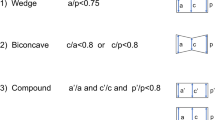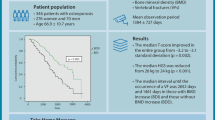Abstract
Summary
Distal radius (wrist) fracture (DRF) in women over age 50 years is an early sign of bone fragility. Women with a recent DRF compared to women without DRF demonstrated lower bone strength, muscle density, and strength, but no difference in dual-energy x-ray absorptiometry (DXA) measures, suggesting DXA alone may not be a sufficient predictor for DRF risk.
Introduction
The objective of this study was to investigate differences in bone and muscle properties between women with and without a recent DRF.
Methods
One hundred sixty-six postmenopausal women (50–78 years) were recruited. Participants were excluded if they had taken bone-altering medications in the past 6 months or had medical conditions that severely affected daily living or the upper extremity. Seventy-seven age-matched women with a fracture in the past 6–24 months (Fx, n = 32) and without fracture (NFx, n = 45) were measured for bone and muscle properties using the nondominant (NFx) or non-fractured limb (Fx). Peripheral quantitative computed tomography (pQCT) was used to estimate bone strength in compression (BSIc) at the distal radius and tibia, bone strength in torsion (SSIp) at the shaft sites, muscle density, and area at the forearm and lower leg. Areal bone mineral density at the ultradistal forearm, spine, and femoral neck was measured by DXA. Grip strength and the 30-s chair stand test were used as estimates of upper and lower extremity muscle strength. Limb-specific between-group differences were compared using multivariate analysis of variance (MANOVA).
Results
There was a significant group difference (p < 0.05) for the forearm and lower leg, with the Fx group demonstrating 16 and 19 % lower BSIc, 3 and 6 % lower muscle density, and 20 and 21 % lower muscle strength at the upper and lower extremities, respectively. There were no differences between groups for DXA measures.
Conclusions
Women with recent DRF had lower pQCT-derived estimated bone strength at the distal radius and tibia and lower muscle density and strength at both extremities.


Similar content being viewed by others
References
Eisman JA, Bogoch ER, Dell R, Harrington JT, McKinney RE Jr, McLellan A, Mitchell PJ, Silverman S, Singleton R, Siris E (2012) Making the first fracture the last fracture: ASBMR task force report on secondary fracture prevention. J Bone Miner Res 27:2039–2046
Osteoporosis Canada (2013) Make the first break the last with fracture liason services. http://www.osteoporosis.ca/wp-content/uploads/FLS-TOOLKIT.pdf. Accessed 5 April 2015
International Osteoporosis Foundation (2012) Capture the fracture: a global campaign to break the fragility fracture cycle. http://share.iofbonehealth.org/WOD/2012/report/WOD12-Report.pdf. Accessed 5 April 2015
Nellans KW, Kowalski E, Chung KC (2012) The epidemiology of distal radius fractures. Hand Clin 28:113–125
Kanis JA (2002) Diagnosis of osteoporosis and assessment of fracture risk. Lancet 359:1929–1936
Papaioannou A, Morin S, Cheung AM et al (2010) 2010 clinical practice guidelines for the diagnosis and management of osteoporosis in Canada: summary. CMAJ 182:1864–1873
Jarvinen TL, Sievanen H, Khan KM, Heinonen A, Kannus P (2008) Shifting the focus in fracture prevention from osteoporosis to falls. BMJ 336:124–126
Stone KL, Seeley DG, Lui LY, Cauley JA, Ensrud K, Browner WS, Nevitt MC, Cummings SR (2003) BMD at multiple sites and risk of fracture of multiple types: long-term results from the Study of Osteoporotic Fractures. J Bone Miner Res 18:1947–1954
Peeters G, van Schoor NM, Lips P (2009) Fall risk: the clinical relevance of falls and how to integrate fall risk with fracture risk. Best Pract Res Clin Rheumatol 23:797–804
Petit MA, Beck TJ, Kontulainen SA (2005) Examining the developing bone: what do we measure and how do we do it? J Musculoskelet Neuronal Interact 5:213–224
D’Elia G, Caracchini G, Cavalli L, Innocenti P (2009) Bone fragility and imaging techniques. Clin Cases Miner Bone Metab 6:234–246
Sheu Y, Zmuda JM, Boudreau RM, Petit MA, Ensrud KE, Bauer DC, Gordon CL, Orwoll ES, Cauley JA (2011) Bone strength measured by peripheral quantitative computed tomography and the risk of nonvertebral fractures: the osteoporotic fractures in men (MrOS) study. J Bone Miner Res 26:63–71
Schneider P, Reiners C, Cointry GR, Capozza RF, Ferretti JL (2001) Bone quality parameters of the distal radius as assessed by pQCT in normal and fractured women. Osteoporos Int 12:639–646
Kontulainen SA, Johnston JD, Liu D, Leung C, Oxland TR, McKay HA (2008) Strength indices from pQCT imaging predict up to 85 % of variance in bone failure properties at tibial epiphysis and diaphysis. J Musculoskelet Neuronal Interact 8:401–409
MacDermid JC, Roth JH, Richards RS (2003) Pain and disability reported in the year following a distal radius fracture: a cohort study. BMC Musculoskelet Disord 4:24
Brogren E, Hofer M, Petranek M, Dahlin LB, Atroshi I (2011) Fractures of the distal radius in women aged 50 to 75 years: natural course of patient-reported outcome, wrist motion and grip strength between 1 year and 2–4 years after fracture. J Hand Surg Eur 36:568–576
Kawalilak CE, Lanovaz JL, Johnston JD, Kontulainen SA (2014) Linearity and sex-specificity of impact force prediction during a fall onto the outstretched hand using a single-damper-model. J Musculoskelet Neuronal Interact 14:286–293
Sran MM, Stotz PJ, Normandin SC, Robinovitch SN (2010) Age differences in energy absorption in the upper extremity during a descent movement: implications for arresting a fall. J Gerontol A Biol Sci Med Sci 65:312–317
Steenhuis RE, Bryden MP, Schwartz M, Lawson S (1990) Reliability of hand preference items and factors. J Clin Exp Neuropsychol 12:921–930
Washburn RA, McAuley E, Katula J, Mihalko SL, Boileau RA (1999) The physical activity scale for the elderly (PASE): evidence for validity. J Clin Epidemiol 52:643–651
Borson S, Scanlan J, Brush M, Vitaliano P, Dokmak A (2000) The mini-cog: a cognitive ‘vital signs’ measure for dementia screening in multi-lingual elderly. Int J Geriatr Psychiatr 15:1021–1027
Lafayette Instrument Company (2004) Jamar hydrolic hand dynamometer user instructions. https://www.chponline.com/store/pdfs/j-20.pdf. Accessed 5 April 2015
Karkkainen M, Rikkonen T, Kroger H, Sirola J, Tuppurainen M, Salovaara K, Arokoski J, Jurvelin J, Honkanen R, Alhava E (2008) Association between functional capacity tests and fractures: an eight-year prospective population-based cohort study. Osteoporos Int 19:1203–1210
Lorbergs AL, Farthing JP, Baxter-Jones AD, Kontulainen SA (2011) Forearm muscle size, strength, force, and power in relation to pQCT-derived bone strength at the radius in adults. Appl Physiol Nutr Metab 36:618–625
McLean RR, Shardell MD, Alley DE et al (2014) Criteria for clinically relevant weakness and low lean mass and their longitudinal association with incident mobility impairment and mortality: the Foundation for the National Institutes of Health (FNIH) sarcopenia project. J Gerontol A Biol Sci Med Sci 69:576–583
Jones CJ, Rikli RE, Beam WC (1999) A 30-s chair-stand test as a measure of lower body strength in community-residing older adults. Res Q Exerc Sport 70:113–119
Rikli RE, Jones CJ (2001) Senior fitness test manual. Human Kinetics, Champaign
Lang T, Streeper T, Cawthon P, Baldwin K, Taaffe DR, Harris TB (2010) Sarcopenia: etiology, clinical consequences, intervention, and assessment. Osteoporos Int 21:543–559
Cousins JM, Petit MA, Paudel ML, Taylor BC, Hughes JM, Cauley JA, Zmuda JM, Cawthon PM, Ensrud KE (2010) Muscle power and physical activity are associated with bone strength in older men: the osteoporotic fractures in men study. Bone 47:205–211
Crockett K, Ardell K, Hermanson M, Penner A, Lanovaz J, Farthing J, Arnold C (2013) The relationship of knee-extensor strength and rate of torque development to sit-to-stand performance in older adults. Physiother Can 65:229–235
Duckham RL, Frank AW, Johnston JD, Olszynski WP, Kontulainen SA (2013) Monitoring time interval for pQCT-derived bone outcomes in postmenopausal women. Osteoporos Int 24:1917–1922
International Society for the Advancement of Kinanthropometry (2001) International standards for anthropometric assessment. http://www.ceap.br/material/MAT17032011184632.pdf. Accessed 5 April 2015
Carter DR, Hayes WC (1977) The compressive behavior of bone as a two-phase porous structure. J Bone Joint Surg Am 59:954–962
Frank-Wilson AW, Johnston JD, Olszynski WP, Kontulainen SA (2015) Measurement of muscle and fat in postmenopausal women: precision of previously reported pQCT imaging methods. Bone 75:49–54
Chilibeck PD, Vatanparast H, Pierson R, Case A, Olatunbosun O, Whiting SJ, Beck TJ, Pahwa P, Biem HJ (2013) Effect of exercise training combined with isoflavone supplementation on bone and lipids in postmenopausal women: a randomized clinical trial. J Bone Miner Res 28:780–793
Sievanen H, Oja P, Vuori I (1992) Precision of dual-energy x-ray absorptiometry in determining bone mineral density and content of various skeletal sites. J Nucl Med 33:1137–1142
Uusi-Rasi K, Sievanen H, Pasanen M, Kannus P (2007) Age-related decline in trabecular and cortical density: a 5-year peripheral quantitative computed tomography follow-up study of pre- and postmenopausal women. Calcif Tissue Int 81:249–253
Marcell TJ (2003) Sarcopenia: causes, consequences, and preventions. J Gerontol A Biol Sci Med Sci 58:M911–M916
Narici MV, Maffulli N (2010) Sarcopenia: characteristics, mechanisms and functional significance. Br Med Bull 95:139–159
Ashe MC, Liu-Ambrose TY, Cooper DM, Khan KM, McKay HA (2008) Muscle power is related to tibial bone strength in older women. Osteoporos Int 19:1725–1732
Hardy R, Cooper R, Shah I, Harridge S, Guralnik J, Kuh D (2010) Is chair rise performance a useful measure of leg power? Aging Clin Exp Res 22:412–418
Nikander R, Sievanen H, Heinonen A, Daly RM, Uusi-Rasi K, Kannus P (2010) Targeted exercise against osteoporosis: a systematic review and meta-analysis for optimising bone strength throughout life. BMC Med 8:47
Rozental TD, Deschamps LN, Taylor A, Earp B, Zurakowski D, Day CS, Bouxsein ML (2013) Premenopausal women with a distal radial fracture have deteriorated trabecular bone density and morphology compared with controls without a fracture. J Bone Joint Surg Am 95:633–642
Engelke K, Libanati C, Fuerst T, Zysset P, Genant HK (2013) Advanced CT based in vivo methods for the assessment of bone density, structure, and strength. Curr Osteoporos Rep 11:246–255
Felsenberg D, Boonen S (2005) The bone quality framework: determinants of bone strength and their interrelationships, and implications for osteoporosis management. Clin Ther 27:1–11
Vico L, Zouch M, Amirouche A, Frere D, Laroche N, Koller B, Laib A, Thomas T, Alexandre C (2008) High-resolution pQCT analysis at the distal radius and tibia discriminates patients with recent wrist and femoral neck fractures. J Bone Miner Res 23:1741–1750
Kontulainen S, Sievanen H, Kannus P, Pasanen M, Vuori I (2002) Effect of long-term impact-loading on mass, size, and estimated strength of humerus and radius of female racquet-sports players: a peripheral quantitative computed tomography study between young and old starters and controls. J Bone Miner Res 17:2281–2289
Acknowledgments
We would like to acknowledge the funding from the Saskatchewan Health Research Foundation (SHRF) for the support of the Bone and Joint Imaging Group and their research at the University of Saskatchewan and to thank all the volunteers for their participation in the study. We would also like to thank Blanc Star, Valerie Wellans, Lauren Lattimer, Heidi Hunt, and Emma Burke for their assistance with data collection.
Conflicts of interest
Katie Crockett, Catherine M. Arnold, Jonathan P. Farthing, Philip D. Chilibeck, James D. Johnston, Brenna Bath, Adam D.G. Baxter-Jones, and Saija A. Kontulainen declare that they have no conflict of interest.
Author information
Authors and Affiliations
Corresponding authors
Rights and permissions
About this article
Cite this article
Crockett, K., Arnold, C.M., Farthing, J.P. et al. Bone strength and muscle properties in postmenopausal women with and without a recent distal radius fracture. Osteoporos Int 26, 2461–2469 (2015). https://doi.org/10.1007/s00198-015-3160-8
Received:
Accepted:
Published:
Issue Date:
DOI: https://doi.org/10.1007/s00198-015-3160-8




